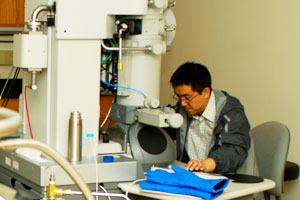New director appointed to Liquid Crystal Institute

SAM VERBULECZ
June 27, 2011
Research institutes rely on grants and contracts to expand and compete; few people at Kent State know that better than Professor Oleg Lavrentovich, the current director of the Liquid Crystal Institute.
“It’s always a competition,” Lavrentovich said. “If you go to a place like the National Science Foundation, the success rate is well below 20 percent.”
“You have to write many proposals to get the grant you want,” he added.
During the 2009-10 school year, Lavrentovich wrote six of LCI’s 53 grant proposals — some as thick as a packet of printer paper — but on Friday a new director will replace Lavrentovich at the institute famous for its research in digital screen displays.
During Lavrentovich’s seven years as director, grant and contract funding has more than doubled from a little less than $2 million in the 2004-05 school year to $4.3 million in the 2009-10 school year.
At the June 2 Board of Trustees meeting, Lavrentovich was officially named the next Trustees Research Professor, a position that works on special projects from the Department of Energy and the National Science Foundation.
Lavrentovich’s successor, Professor Hiroshi Yokoyama, was hired in 2009 after LCI won an Ohio Research Scholars Program award in 2008 thanks to Lavrentovich’s efforts. The grant is a program financed by the state government to increase academic-led research that supports the regional economy. It awarded two endowments equaling $5 million to fund the salaries for two new tenure-track faculty positions.
Yokoyama filled the first position and the other is expected to be filled in early Fall 2011, said Lavrentovich.
“It will be great to see the continuation of the successful goals of the institute under the leadership of (Yokoyama),” Lavrentovich said.
Yokoyama will begin his new position as LCI director July 1. He said his goal for LCI’s future is to “enhance (LCI’s) relationship with industry” by broadening the functions to liquid crystal research beyond monitors and electronics.
“Sometimes changes are necessary to continue development,” Yokoyama said.
Nowadays, more and more private-sector companies are employing in-house research and development teams to produce newer products, Yokoyama said.
Philip Bos, Director of LCI’s Industrial Partnership Program, has seen the same trend. Companies typically do it to secure intellectual property rights, he said.
To work around this trend, LCI is studying new, unfamiliar applications for liquid crystals that apply to cancer care, 3D vision and solar energy.
Liquid Crystals Institute studies the technology of electronic displays.
LCI’s relationship with industry:
– Works with big-name entities, including Intel, HP, NASA and Samsung
Services offered:
– Sponsors projects with companies
– Provides training and facilities
– Curates educational workshops
Assets of LCI:
– The 2,500-square foot clean room keeps all bacteria outside. Kent State approved investment for new equipment in the clean room earlier this month.
– The Transmission Electron Microscope uses electrons to visualize objects as small as atoms. The microscope was bought using funds provided by the Ohio Research Scholars grant earlier this year.
Earlier in June, the provost office announced the university is searching to hire two new tenure-track faculty members who hold a background in “organic photovoltaics,” which uses organic molecules to absorb lucrative amounts of solar energy with less material. The Ohio Research Scholar position that’s expected to be filled sometime early fall semester will also have a background in a similar energy field.
“We have a lot of new developments,” Lavrentovich said.
Grants and contracts aren’t the only sources of funding LCI relies upon. Almost every year, Kent State University steadily increases its funding to LCI, from less than $500,000 in the 1983-84 school year to $2.54 million in the 2009-10 school year. In the 2009-10 school year, Kent State made up 37 percent of LCI’s total funding.
Timothy Chandler, senior associate provost, and Tim Martin, associate vice president for academic budget and resource management, said the increase reflects the increase in salaries the university pays to LCI, which Chandler added were in line with most faculty departments.
“There’s no money being pumped into it specifically for new items,” Chandler said of LCI. Chandler added that there are times when LCI will come to the university to ask for start-up funding on a project.
“That would be one-time funding instead of an addition to their budget,” Chandler said.
Contact Summer Kent Stater reporter Simon Husted at [email protected].











